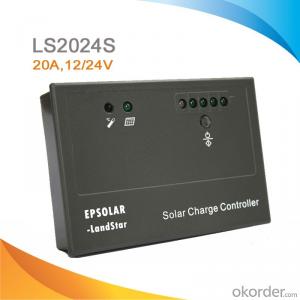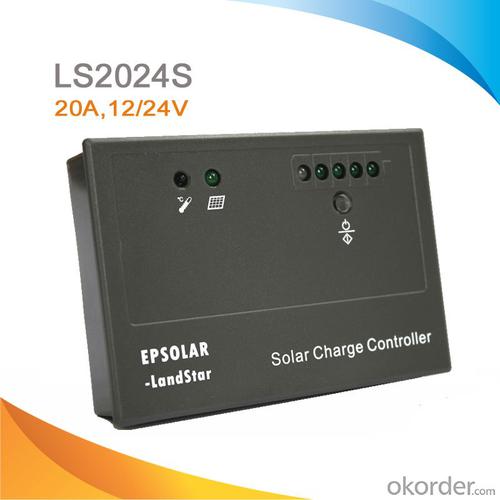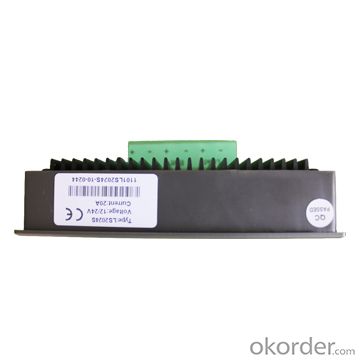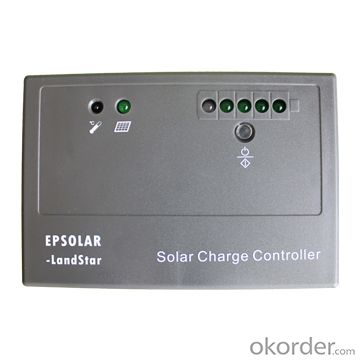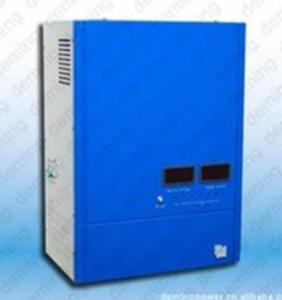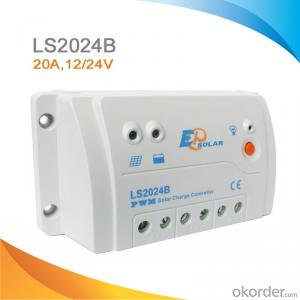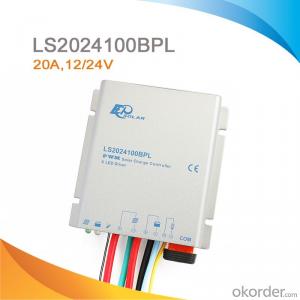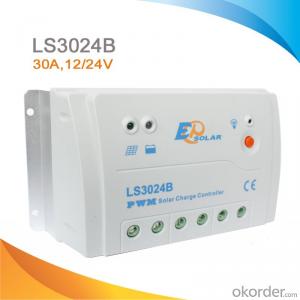Solar and Wind Charge Controllers:Surface Mounting PWM Solar Panel Charge Regulator/Controller, 20A, 12V/24V, LS2024S
- Loading Port:
- China main port
- Payment Terms:
- TT or LC
- Min Order Qty:
- -
- Supply Capability:
- -
OKorder Service Pledge
OKorder Financial Service
You Might Also Like
Features:
·High efficient Series PWM charging
·Use MOSFET as electronic switch
·Gel, Sealed and Flooded battery type option
·Temperature compensation
·LED indicators indicate battery voltage state
Electronic Protections:
·over charging
·over discharging
·overload
·short circuit
·Reverse protection for battery
Specification:
Electrical parameters | LS1024S | LS2024S |
Nominal System Voltage | 12 / 24VDC auto work | |
Rated Battery Current | 10A | 20A |
Max. Battery Voltage | 32V | |
Charge Circuit Voltage Drop | ≤0.26V | |
Discharge Circuit Voltage Drop | ≤0.15V | |
Self-consumption | ≤6mA | |
Overall dimension | 120 x 68 x 40mm | 128 x 87x 48mm |
Terminal | 4mm2 | 10mm2 |
Net weight | 0.15kg | 0.25kg |
Working temperature | -35℃ to +55℃ | |
Humidity | 10%-90% NC | |
Enclosure | IP30 | |
Battery Voltage Parameters (temperature at 25℃) | |||
Battery charging setting | Gel | Sealed | Flooded |
Equalize Charging Voltage | —— | 14.6V;x2/24V | 14.8V;x2/24V |
Boost Charging Voltage | 14.2V;x2/24V | 14.4V;x2/24V | 14.6V;x2/24V |
Float Charging Voltage | 13.8V;x2/24V | 13.8V;x2/24V | 13.8V;x2/24V |
Low Voltage Reconnect Voltage | 12.6V;x2/24V | 12.6V;x2/24V | 12.6V;x2/24V |
Low Voltage Disconnect Voltage | 11.1V;x2/24V | 11.1V;x2/24V | 11.1V;x2/24V |
Equalize Duration | —— | 2 hours | 2 hours |
Boost Duration | 2 hours | 2 hours | 2 hours |
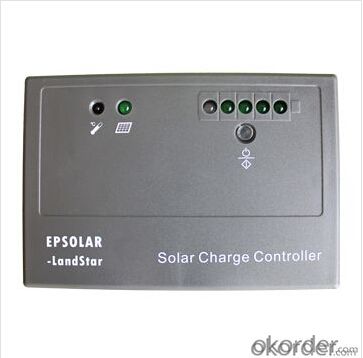
FAQ:
Q1. What is the voltage?
A1. Our 45/60A solar charge controller is 12/24/36/48V auto work.
Q2. What is the difference between MPPT&PWM?
A2. MPPT has higher efficiency, it can track the max power point and won't waste energy.
Q3. What is the efficiency of the MPPT controller?
A3. MPPT>99%, peak conversion efficiency>98%.
Q4. What is the waranty of product?
A4. 12 months.
Q5. What protection does your MPPT controller have?
A5. PV array short circuit, PV reverse polarity, Battery reverse polarity, Over charging, Output short circuit.
- Q: Can a solar controller be used with solar-powered electric fences for agricultural applications?
- Yes, a solar controller can be used with solar-powered electric fences for agricultural applications. The solar controller helps regulate the power supply from the solar panels to the electric fence, ensuring optimal charging and operation of the fence. It helps maintain the battery's health and prevents overcharging or undercharging, maximizing the efficiency and reliability of the electric fence system.
- Q: Can a solar controller be used in a solar-powered electric wheelchair charging system?
- Yes, a solar controller can be used in a solar-powered electric wheelchair charging system. A solar controller helps regulate the charging of batteries by managing the flow of electricity from the solar panels to the batteries. In a solar-powered electric wheelchair charging system, the solar controller ensures that the batteries are charged efficiently and safely, maximizing the performance and lifespan of the batteries.
- Q: Can a solar controller be used with solar panel theft prevention systems?
- Yes, a solar controller can be used with solar panel theft prevention systems. The solar controller helps regulate the flow of energy between the solar panels and the batteries, ensuring optimal charging and preventing overcharging or damage. By integrating the solar controller into the theft prevention system, it can enhance its functionality by providing real-time monitoring and control of the solar panel system, making it more secure against theft attempts.
- Q: Can a solar controller handle different load types (e.g., resistive, inductive)?
- Yes, a solar controller can handle different load types such as resistive and inductive. The controller is designed to regulate and control the flow of power from the solar panels to the connected load, regardless of the load type.
- Q: Can a solar controller work with different types of solar panels?
- Yes, a solar controller can work with different types of solar panels as long as they have compatible voltage and current ratings. The solar controller regulates the charging process and ensures that the energy generated by the solar panels is efficiently stored in the battery or used to power devices. However, it is important to check the specifications and compatibility requirements of both the solar controller and the solar panels to ensure proper functioning and optimal performance.
- Q: How does a solar controller handle low battery voltage disconnect?
- A solar controller handles low battery voltage disconnect by monitoring the voltage level of the battery. When the voltage drops below a certain threshold, typically around 11.5 to 11.8 volts, the controller automatically disconnects the solar panels from the battery to prevent further discharge. This helps protect the battery from deep discharge, which can damage its capacity and lifespan.
- Q: Can a solar controller be used with solar-powered electric fences?
- Yes, a solar controller can be used with solar-powered electric fences. A solar controller is designed to regulate and optimize the charging of batteries in solar power systems, which can be utilized in solar-powered electric fences to ensure efficient energy storage and usage.
- Q: How does a solar controller handle variations in battery charge level?
- The primary purpose of a solar controller is to regulate the charging process in order to accommodate changes in battery charge level. By monitoring the battery voltage, the controller is able to adjust the charge rate accordingly, ensuring that the battery is not overcharged or undercharged. When the battery charge level is low, the solar controller permits maximum current from the solar panels to flow into the battery, resulting in a rapid and effective charge. As the battery charge level increases, the controller gradually reduces the charging current to prevent overcharging. This adjustment is made possible through the utilization of either pulse width modulation (PWM) or maximum power point tracking (MPPT), depending on the type of solar controller. In the case of a PWM solar controller, the charging current is periodically interrupted to maintain a consistent voltage, preventing the battery from becoming overcharged. The controller continuously monitors the battery voltage and alters the duty cycle of the charging current in order to maintain the desired voltage level. On the other hand, an MPPT solar controller operates at a more advanced level by continuously tracking the maximum power point of the solar panels. It adjusts the voltage and current to align with the optimal charging parameters, thereby maximizing the power output from the panels and ensuring efficient charging, even when the battery charge levels fluctuate. In both scenarios, the solar controller serves as a regulator, constantly monitoring the battery charge level and making necessary adjustments to the charging process. This guarantees the safe and efficient charging of the battery, extending its lifespan and maximizing the utilization of solar energy.
- Q: Can a solar controller be used with solar-powered indoor sports facilities?
- Solar-powered indoor sports facilities can indeed utilize a solar controller. This device serves to regulate the flow of electricity from the solar panels to the battery bank, efficiently charging the batteries and preventing overcharging or undercharging. To harness sunlight and convert it into electricity, solar panels can be installed on the roof or in a nearby location of these facilities. The solar controller will then oversee the charging process, guaranteeing optimal battery charging. Given that indoor sports facilities require a substantial amount of electricity to power various equipment, lighting, and ventilation systems, incorporating solar power allows for reduced reliance on the grid and lower energy costs. Additionally, solar power aligns with sustainability goals and reduces the facility's carbon footprint as it is a clean and renewable energy source. The solar controller will constantly monitor the battery voltage and adjust the charging current to maintain the batteries at their optimal voltage levels. It also protects the batteries by preventing overcharging, which can lead to reduced battery lifespan or damage. Furthermore, the solar controller can offer valuable data and insights regarding the energy production and consumption of the indoor sports facility. This information can be utilized to optimize energy usage, identify areas for improvement, and potentially implement energy-saving measures. To summarize, a solar controller effectively regulates the charging process in solar-powered indoor sports facilities, ensuring optimal battery performance and maximizing the utilization of solar power.
- Q: Can a solar controller be used in a solar-powered cargo ship?
- Yes, a solar controller can be used in a solar-powered cargo ship. A solar controller plays a crucial role in managing and regulating the flow of electricity from solar panels to the ship's battery bank. It ensures that the solar panels are operating at maximum efficiency, protects the batteries from overcharging and optimizes the power output. By integrating a solar controller, a solar-powered cargo ship can effectively harness solar energy to support its electrical needs, reducing reliance on traditional power sources and promoting sustainable shipping practices.
Send your message to us
Solar and Wind Charge Controllers:Surface Mounting PWM Solar Panel Charge Regulator/Controller, 20A, 12V/24V, LS2024S
- Loading Port:
- China main port
- Payment Terms:
- TT or LC
- Min Order Qty:
- -
- Supply Capability:
- -
OKorder Service Pledge
OKorder Financial Service
Similar products
Hot products
Hot Searches
Related keywords
